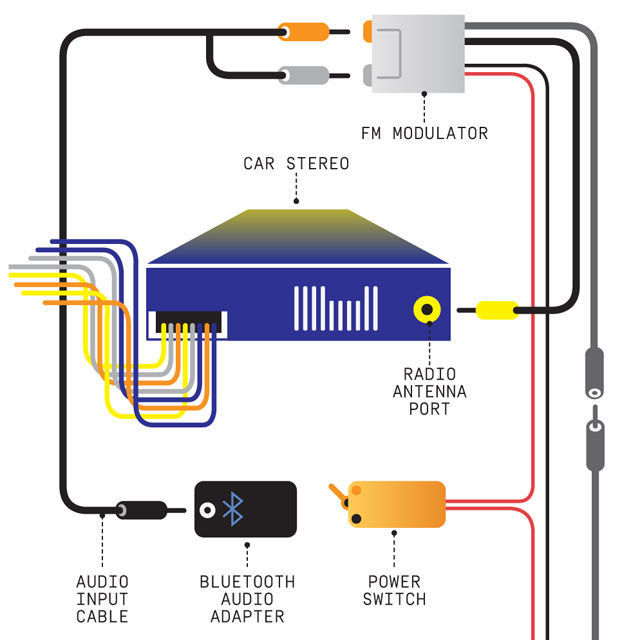Bluetooth audio is common in new cars, but if your ride is a few years old you might not be able to stream audio through the radio. Other options exist: Your car may have an auxiliary input that connects any audio source via a 3.5-mm (⅛-inch) minijack; older cars might even take a cassette adapter. But both of these solutions add clutter to the interior. Here's a cheap way to put wireless audio in any car without adding unsightly cords or even changing the appearance of the factory audio system.
MORE FROM POPULAR MECHANICS
SHOPPING LIST
Wired FM Modulator: Be sure it includes antenna connection cables, as well as a power switch. ISimple's IS31 Antenna Bypass FM Modulator has everything you need for about $30, but we found plenty of generic models on eBay for under $25.
Audio Input Cable: 3.5-mm stereo male to dual RCA stereo male. Stores sell these for less than $10. You can find them online for even less.
Bluetooth A2DP Adapter: Look for one with a 3.5-mm input and USB charging. A good example is the EDUP EP-B3503, which goes for about $24. Again, no-name units can be found for less on eBay.
USB Car-Charger Adapter: This charges the Bluetooth adapter. Don't pay more than $5 for one online.
Zip Ties: For gathering up dangling wires.
Splice Connectors:We like this style of connector because it's almost foolproof, ensuring that you have to do the job only once.
Tools: Aside from the basics (screwdrivers, wrenches), you'll need
• Voltmeter or 12-volt circuit tester
• Wire strippers
THE HOW-TO
The general concept is simple, but you need to be comfortable with taking your interior apart and working under the dashboard. Here's how it's done:
Remove the Radio: Disassemble the necessary trim and pull the stereo out of its mount to expose the rear of the head unit. This may require a specialized stereo-removal tool. For help on this, consult your car's service manual or check online forums. Take pictures of the process so you can put things back together in the correct order.
Connect the Modulator: Remove the antenna cable. Then plug the wired FM modulator into the antenna connection on the radio, and the antenna cable into the FM modulator. If the FM modulator has a frequency selector, choose the frequency with the least interference in your area. Some cars (such as GM and Nissan models starting in the late 1980s, and plenty of others in the 21st century) use oddball proprietary antenna connectors on factory radios instead of the typical Motorola connector. If this is the case with your car, you may need to buy an antenna-connector adapter.
Find Power: Use a voltmeter or circuit tester to look for a wire that has juice when the ignition switch is in the on or accessory position, and is dead when the key is switched off. The radio circuit is your best bet. Here again, your car's service manual or the Internet will help a lot.
Connect Power: Using splice connectors, attach the wire from the power switch that came with the FM modulator to the power source you located in the previous step. If the modulator does not have an inline fuse, we recommend adding one to the positive wire. Connect the ground wire from the FM modulator to a good ground connection under the dash. Mount the FM modulator's power switch in a convenient location, near the radio or center console.
Tidying Up: Plug the RCA connectors of the audio input cable into the FM modulator. Route the end with the 3.5-mm plug to a location inside the glovebox, center console, or other easily accessed but hidden location. Secure the FM modulator under the dash with zip ties. Gather the loose wires with additional zip ties. Don't make it too tight—you don't want to crimp any wires.
Test the Audio: Turn the ignition on, power up the FM modulator, and connect an audio device to the 3.5-mm plug; tune the radio to the FM modulator's frequency, and make sure you're getting a good audio signal.
Add Bluetooth: Remove your test connection. Charge your Bluetooth adapter and pair it with your smartphone, tablet, or MP3 player. Connect the 3.5-mm plug to the Bluetooth adapter. You should be able to feed audio through your radio with Bluetooth now.
Bonus Step: If you want to get fancy, hardwire a USB car charger into the same power source you used in "Connect power" and keep the Bluetooth adapter plugged in at all times. This will require disassembling a USB car charger and soldering wires to the charger's power circuit. If you're not up for that, keep a charger in the car and recharge the Bluetooth adapter when needed—that's what we did.
Replace Trim: Put all the panels you removed to access the radio back in place. Congratulations—now you can stream Bluetooth audio.


没有评论:
发表评论